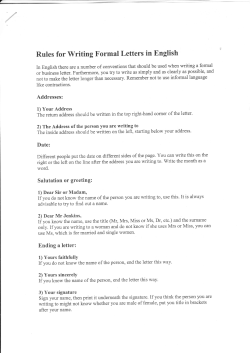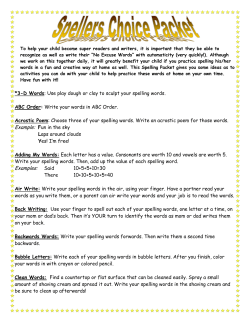
Prince’s Trust/ Microsoft Writing formal letters Introduction
Prince’s Trust/ Microsoft Activity 2 Writing formal letters Introduction Today most of us use our phones to text and call people. If we have some business to do or an important enquiry to make we may send an email. But when you start applying for jobs, that changes. Many employers will ask job applicants to write a letter explaining why they are the right person for a particular job. Writing letters and the Team programme During the Team programme you will write important letters to different people and organisations. These letters will include: - requesting donations - requesting community project support - enquiring about work placements - job search letters - short covering letters - longer application letters Writing a good letter can take a lot of effort, particularly if you have not written many letters before. The following section gives tips on how to lay out letters and then you will do an activity that will give you the chance to use your word processing skills to create impressive formal letters. For more details of the pilot, please go to: www.princes-trust.org.uk/itpilot. It is important that you practice these skills because they will help you do well during the Team programme. Being able to write a good application letter will also help you apply for jobs in the future. A few reminders Here is a picture of a blank letter and a list of letter ingredients. Could you use this list to label each part of the letter? 1. 2. 3. 4. 5. 6. 7. 8. Yours … 9. Your signature Date 10. Middle paragraph Closing paragraph 11. Heading The address of the organisation you are writing to Your name printed Introductory paragraph Dear…. Your address Here are a number of word processing features that are often used to arrange information within a letter. Which ones you would use to create the above letter? A align left E line spacing B underline text F spelling and grammar check C bold text G tabs D centre H align right For more details of the pilot, please go to: www.princes-trust.org.uk/itpilot. Top Tips for writing formal letters All the letters you create on the Team programme are formal letters. That means they should appear business-like and follow a standard layout. All your letters should be word processed and printed on good quality A4 paper. Keep your letters brief – one side of A4 is usually enough. All formal letters must include your address and contact details as well as the address of the person you are writing to. It also makes sense to include a short heading highlighting the purpose of your letter. In the first paragraph explain why you are writing- e.g. I am replying to your advert in the Local Guardian for the job of shop assistant, or, I am writing to ask whether your company would support our community project by supplying some building materials. If it is an application letter, use the middle paragraphs to tell them how your skills and experience match up to their requirements. E.g. I recently completed a work experience placement at the local Department Store and enjoyed helping customers and working with the other people in the shop. My placement report also said that I was good at timekeeping and that I dressed appropriately for work. If it is a letter requesting information or a donation, make sure you explain exactly what you need and by when. E.g. our project aims to decorate a hall used by a parents and toddler group in time for their Christmas Party. To do this we need companies to sponsor us by supplying materials like paint and washable flooring. In the final paragraphs, you need to finish the letter in a positive way, e.g. by saying “I look forward to hearing from you.” If you want some more tips on how to create formal letters before you do the practice tasks, have a look at the “Brush up your word processing” document first. For more details of the pilot, please go to: www.princes-trust.org.uk/itpilot. Practice Tasks Here are two short tasks. Do the one that seems most relevant to you. You can use a letter template or design the letter yourself. You will find lots of help on how to create a formal letter in the word processing section of “Brush Up your IT Skills”. You saw an advert for a warehouse assistant to join your local supermarket when you visited the Job Centre. The job advert stressed that they were looking for someone with some retail experience who was punctual and had good communication skills. You have recently completed a placement at a local builder’s merchant which you enjoyed. Write a formal covering letter to the personnel officer Mrs. Farrah Jones at Booths Stores, 22 the High Street, Wrightington Lancashire, WG42 3YH. Explain why you would be the right person for the job and say you are enclosing your CV. Your Team programme is going to help a local old people’s home turn a garden lawn into a vegetable patch for residents to look after. This will help them save money on food and encourage them to keep active. You need to get the following materials: bags of compost, gardening equipment and plants. Write a formal letter to The Manager, Portview Garden Centre, Smithsfield, Hull, HL15 3HN explaining what you are doing and why it is a good idea. Explain what help you need and ask them to make a generous donation. Use the form provided to record this task. You can cut and paste the form into a new document once you have completed the task. The more you practice writing letters, the better you will get at it. This will make it much easier for you to apply for jobs. If you have another 15 minutes, why not try the other practice task now? For more details of the pilot, please go to: www.princes-trust.org.uk/itpilot. Your name: Writing a formal letter Highlight the word processing features that you used in your letter. align left centre align right justified line spacing tabs underline text bold text spelling check grammar check List any other features you used (e.g. font, font size, italics, styles, indents, etc). Read your letter carefully. Can you spot any spelling mistakes? Does the layout of the letter look business-like? How could improve the layout? Does the letter read well? How could you improve what you have written? Has the letter printed well? Would you change the print settings if you had to print it again? What was most difficult about writing this letter? Who would you ask to help you write letters in future? Cut and paste this form into a new document, complete the form and save it. Now print your letter and the form and keep them in your ILR as evidence of your IT skills. Remember, if you are going to use this work as evidence towards a qualification you will need to prove that it is all your own work. Finally, email your letter and the completed form as attachments to xx (Team contact) and copy to microsoftpilot@princes-trust.org.uk. Team leader comments: These learning materials are new and we would appreciate your feedback on how to improve them. Please send your comments to microsoftpilot@princes-trust.org.uk. For more details of the pilot, please go to: www.princes-trust.org.uk/itpilot.
© Copyright 2025





















